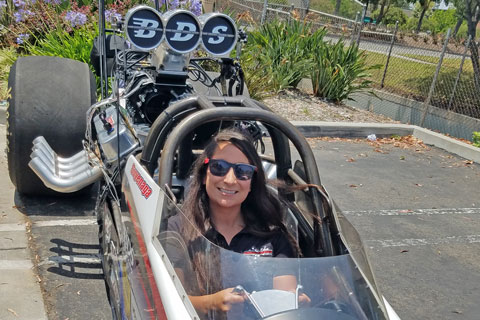PEOPLE
2022 SEMA Hall of Fame Welcome Walker Evans, Jack Roush and Gene Winfield
By Chris Shelton
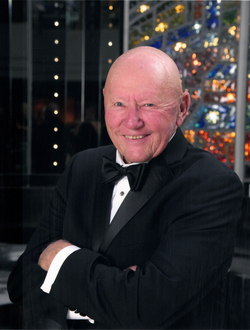
It seems simple enough to elect three industry leaders from an organization that boasts more than 6,500 members. But as the SEMA Board and its Hall of Fame Task Force members will testify, it’s no easy job. How does one—much less a group of many—choose just a handful of people to induct into its annual Hall of Fame? It’s an unenviable task, to say the least.
The SEMA Hall of Fame award honors those who built the specialty-equipment market into the $51 billion powerhouse it is today. Since 1969, SEMA has inducted some 170 pioneers. For 2022, it adds three more: Walker Evans, Jack Roush and Gene Winfield.
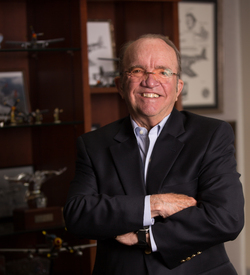
If you love trucks, you owe a debt of gratitude to Walker Evans. Before he won the 1979 Baja 1000 in a ’78 Dodge pickup, trucks were largely relegated to towing the buggies and bikes that won the event every year prior. Starting as a driver for famed builder Bill Stroppe, Evans eventually set up his own shop building some of the most competitive trucks in off-road motorsports. At the turn of the millennium, he switched gears to develop and manufacture a line of performance products. Today Walker Evans Racing is a fixture across the off-road spectrum from Jeeps to snowmobiles.
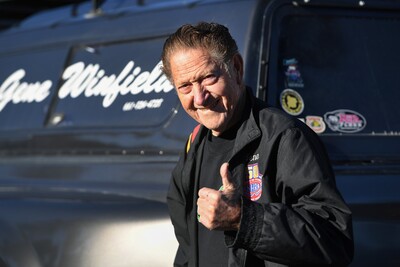
It’s impossible to describe Jack Roush with any single title. His parent company has three units. Roush Performance develops and sells performance vehicles and aftermarket performance parts. Roush CleanTech develops clean-fuel solutions for fleet vehicle applications. Roush Industries designs, engineers, prototypes, tests and even manufactures across industries the mobility, aerospace, defense and theme-park industries. But it all began with OEM engineering jobs that morphed into a brief stint as a multi-
championship drag-racing enterprise. If Jack Roush hasn’t done it, it’s probably not worth doing.
Few people have inspired a more diverse array of automotive enthusiasts than Gene Winfield. A customizer of the first order, his career spans more than seven decades to include the golden age of the custom car. Scale-model manufacturers rendered his creations in miniature and, after recognizing his widely ranging talents, ultimately hired him to create full-scale examples. Soon the entertainment industry caught on to Winfield’s magic, giving him yet another career building for Hollywood—a professional arc that culminated in his shop building the automotive props for big-budget productions like Blade Runner and Back to the Future II.
Walker Evans: All-Terrain Ambassador
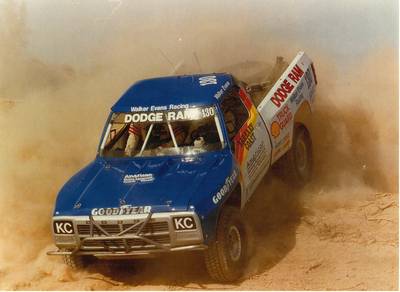
In 1979 Evans almost singlehandedly changed the way people thought about trucks by winning the Baja 1000 in one, the first in the event’s history. The current crop of long-travel rear suspensions can trace their ancestry to the novel cantilever design that helped make this truck so competitive. Fun fact: Evans did it with all the windows in place and the air conditioning blasting. Courtesy Walker Evans.
Today the light truck represents one of the preeminent and most lucrative divisions within the automotive market. But until 1979, the pickup represented little more than a support vehicle, something that would facilitate activities rather than spearhead them.
But that year a pickup did something unprecedented in the field of motorsports. In the hands of team owner, builder and driver Walker Evans, it beat a field of the most competitive dune buggies and motorcycles to win what’s arguably the most grueling auto-racing event in North America: the Baja 1000. It’s a win that transformed not just the off-road racing industry but the modern truck market as we know it.
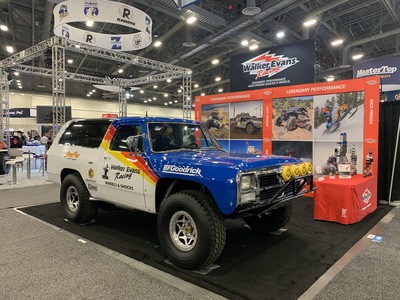
In 2000, Evans quit driving full-time to transform his enterprise into a bona fide manufacturer. The first product line included wheels and shocks, but under his guidance and with the help of SEMA and its affiliates, Walker Evans Racing expanded to include parts and accessories for Jeeps, ATVs and snowmobiles. Courtesy Walker Evans.
Evans began racing in 1967, two years before actor James Garner and Fleetwood RV’s John Crean hired him to build engines for their American-Motors off-road race team. Though designated ride-along mechanic at 1969’s Baja 500, Evans found himself behind the wheel when driver Crean fell ill. His third-place finish inspired him to build an entry of his own, a Ford pickup prepped by legendary builder Bill Stroppe.
The Stroppe relationship led to a 1974 contract with teammate and event promoter Mickey Thompson, who a year prior founded the SCORE off-road sanctioning body. Though known now as Southern California Off Road Enterprises, Mickey initially branded it as Short Course Off Road Enthusiasts and hired Evans to build the organization’s flagship track at Riverside International Raceway, a course that served as a test bed for what became Mickey Thompson Entertainment Group’s successful short-course racing series.
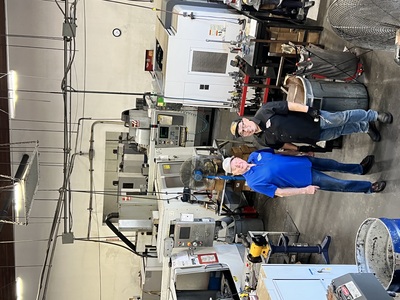
In 2000, Evans (left) quit driving full-time to transform his enterprise into a bona fide manufacturer. The first product line included wheels and shocks, but under his guidance and with the help of SEMA and its affiliates, Walker Evans Racing expanded to include parts and accessories for Jeeps, ATVs and snowmobiles. Courtesy Walker Evans.
Evans raced with Stroppe until he founded his own team, Walker Evans Racing, in 1976. But it was a 1978 deal struck with Chrysler’s Dick Maxwell that changed everything. With factory backing, the team built a D100 pickup with innovations like a cantilever rear suspension and amenities like air conditioning. After only the briefest test session at Riverside, the team took the truck to the 1979 Baja 1000 where Evans proceeded to win not just Class 8, but the overall race—a first for a truck in the event’s history and an accomplishment that heralded the future of trucks in the motorsports and enthusiast markets.
Over the decade that followed, Evans oversaw the shop’s operations and either participated—and, in some cases, played instrumental developmental roles—in numerous sanctioning bodies. These included Short-Course Off Road Driver’s Association (SODA), Championship Off Road Racing (CORR) and High Desert Racing Association (HDRA). He also competed in NASCAR’s SuperTruck Series in 1995 and 1996. In a driving career that spanned 31 years, he amassed a whopping 142 overall and class victories, nine of those at SCORE Baja 1000 events.
“Ever since 1967 I raced full-time right up to 2000,” Evans recalls. “I had like 18 to 19 full-time employees manufacturing trucks, preparing them for almost all the races put on by whatever promoter. That was my full-time living.
“Right about that time is when I made a trip to China with a group of SEMA guys,” he recalls. “At the time I told them that I needed to go right away to put together a deal to meet with people in China to have some wheels made. Well, they said, ‘we’re going next week!’ I asked if they minded some company. ‘Mind? No! We’re wide open!’”
The China Expedition, a delegation formed to explore business opportunities, changed Evans’ focus. Inspired by the prospect of competing in a more global market, he began manufacturing wheels and shock absorbers, naturally promoting his products at SEMA’s annual Las Vegas trade show. “My company literally took off from that point.
“It was one of the greatest things that happened to me,” he continues. “If you accompany them, you’ll wind up meeting the right people and making great parts over there. They were excited to help me do it!”
For more than 50 years, Walker Evans has led the pack at every level of the off-road racing industry, first as driver, then as constructor, team owner and, ultimately, manufacturer. His career follows the arc of the industry’s grassroots model: He began as a young racer who leveraged his successes on the track into a prosperous business, becoming a legend in the process.
He excelled at every level of the performance industry. As a racer, he’s one of the most accomplished drivers, builders and team owners in off-road. As an entrepreneur, he excelled in promoting whatever activity that he participated in. As an employer, he mentored employees who went on to join SEMA and establish successful businesses of their own. And as a person, he facilitated some of the strongest working relationships the industry has known.
SEMA owes a large part of its identity and prestige to Walker Evans’s achievements and exuberant personality. And the world at large owes the popularity of the pickup in a sporting rather than supporting role to his endeavors on the track.
Jack Roush: The Engineer of Enterprise
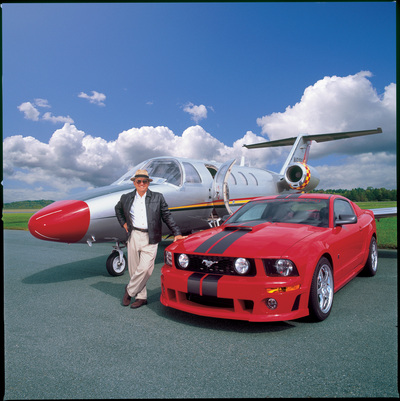
In 1995 Roush began manufacturing parts and accessories for Ford vehicles. Later that year, the company began modifying Mustangs sold exclusively through Ford dealers. The Enhanced Ford Vehicles program now includes pickups. He pursues his other passion, aircraft, through the aerospace division of Roush Industries and through Roush Aviation, which supplies parts and certification services for vintage aircraft. Courtesy Roush.
Make no mistake: the automotive industry has produced its fair share of titans. But few have ascended the ranks quite as meteorically as Jack Roush. His various companies have produced more than 30,000 special-edition vehicles, won more than 400 national motorsports events and 30 championships, employ more than 5,000 people in five states and 19 countries, and generate nearly half a billion dollars in revenue annually.
Roush graduated from Berea College in 1964 with a mathematics major and a physics minor. He moved to Detroit that year and took a job in quality control at Ford’s Dearborn plant. Drawn by Ford’s extensive motorsports activities, he joined a group of fellow racing enthusiasts, The Fastbacks, in 1966.
He left Ford to work for Chrysler in 1969 but maintained relationships with former Ford colleagues. In 1970, he earned his master’s in Scientific Mathematics at Eastern Michigan University and left Chrysler to teach physics and automotive classes at Monroe County Community College. That year, he also teamed up with one of his former Ford colleagues, engineer Wayne Gapp. Roush attended his first SEMA Show in 1971, securing sponsorship for the 1972 Gapp and Roush Pro Stock Drag Racing Program. The team campaigned in NHRA, IHRA and AHRA events and won the NHRA Pro Stock championship in 1973. Gapp and Roush won three more championships over the two years that followed.
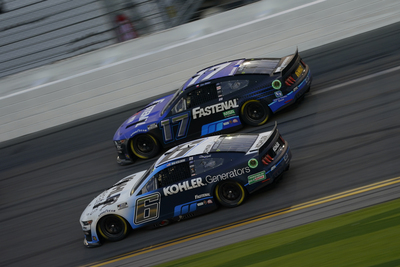
Since entering NASCAR in 1988, cars campaigned by Roush and his partners have covered nearly 2 million mi. and won more than 325 events. Most recently, Roush and partner Fenway Sports Group added driver Brad Keselowski to create RFK Racing. Keselowski drives the No. Ford Mustang GT. Chris Buescher fields the No. 17 Mustang. Photo courtesy: Roush.
Recognizing that domestic manufacturers were finding ways to rein in spending by minimizing the thing he excelled at—engineering—Roush ventured out as an independent consultant, founding Jack Roush Performance Engineering in 1976. He personally hired the firm’s first 100 employees, cultivating an organization of highly creative and divergent thinkers.
While Roush stopped operating a race team in the late ’70s, his company remained in motorsports by building engines for teams throughout the early ’80s. In 1982, he partnered with German firm Zakspeed to develop road-racing vehicles for Ford. In 1984, Roush returned to racing as a team owner in the Sports Car Club of America (SCCA) and International Motor Sports Association (IMSA) road-racing series. Through the remainder of the decade and into the following, Roush’s drivers won 119 races, 24 national championships and 12 manufacturer’s championships. Roush also captured 10 consecutive sedan-class wins at the 24 Hours of Daytona, an unbeaten record.
Roush formed his first NASCAR Cup Series team in 1988, with future hall-of-famer Mark Martin behind the wheel of the #6 Thunderbird, and in the following year Roush Racing won its first NASCAR Cup Series victory.
An engineer at heart, Roush created numerous technological and safety features. He co-developed roof flaps to prevent stock cars from taking flight while spinning, a lifesaving feature required by all NASCAR entries since 1994.
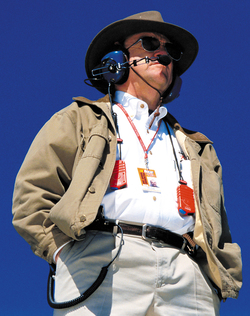
In the early ’90s, Roush bought a pre-production SN-95 Mustang from Ford to develop a line of products under the Roush Performance banner. The venture culminated with a special-vehicle program where select Ford dealers sold Mustangs modified by Roush Performance. Over the decades that followed, Ford and Roush expanded the special-vehicle program to include the Focus and F-150. Roush Performance modifies Ford products to the extent that the company is listed as Manufacturer of Record, some models bearing warranties serviced by Roush rather than Ford.
Roush and Doug Yates partnered to form Roush Yates Engines in 2005. The Mooresville, North Carolina, shop supplies engines to Roush Fenway Racing, Team Penske and numerous teams in the NASCAR Cup, XFINITY, Truck and ARCA Series. Sister company Roush Racing joined Fenway Sports Group (FSG) to form Roush Fenway Racing in 2007.
Under Roush’s guidance, Roush Fenway won its first Daytona 500 trophy and the team’s 2,500th NASCAR Cup Series start in 2009. In 2021, Brad Keselowski joined the organization as owner/driver under its new name, Roush Fenway Keselowski (RFK) Racing.
Though known for his participation in the automotive industry, Roush and the companies he formed play pivotal roles within the electronics, entertainment, aviation and aerospace industries. He began developing propane-fuel systems in 2008 and in 2010 formed Roush CleanTech to convert fleet vehicles. Roush Industries built the Firefly network of vehicles for Waymo, Google’s autonomous-vehicle program, and converts the Chrysler Pacifica vans that replaced the Firefly upon its retirement in 2017. The company is also designing engines for NASA’s so-called space-taxi program that promises to make space exploration more accessible. Another subsidiary, Roush Entertainment Services, designs and builds theme-park rides.
Though active in so many industries, Jack Roush remains a significant presence in SEMA activities. He’s participated as attendee, exhibitor, celebrity guest of various manufacturers, including Ford Motor Company, and by preparing concept vehicles for numerous automakers. He still consistently employs SEMA’s Global Platform to launch new products.
Gene Winfield: The Ace of Fades
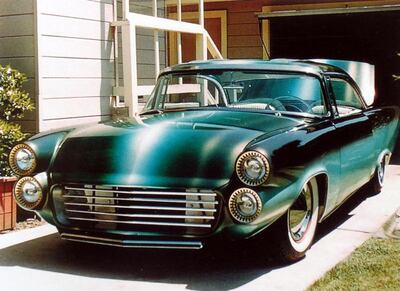
The car that Winfield restyled in the late ’50s emerged unrecognizable from the ’56 Mercury that it started as. “Jade Idol” showcased the customizer’s metalshaping chops and its distinctive fade paint job put it at the forefront of the custom-car movement. Winfield owes much of his recognition to his promotional abilities; he and his crew toured the country attending car shows with “Jade Idol” for several years. Courtesy Gene Winfield.
There’s probably no better way to light a fire in potential consumers’ hearts and minds than to show the potential in a company’s goods or services. And few people have done it better than custom-car pioneer Gene Winfield.
In 1942 a 15-year-old Winfield bought his first car, a ’28 Ford coupe, for $75. The antenna he installed was more an array for the foxtail that topped it, for the car had no radio.
In 1946, inspired by the photos of custom cars he and his pal Bart Bartoni took and exchanged, Winfield converted an oversized chicken coop behind his family’s home in Modesto, California, into Windy’s Custom Shop, a dirt-floor auto salon. That year he also co-founded the Modesto Century Toppers car club, a group made of mostly by friends who brought their cars to Winfield for modifications. They elected him the club’s first president.
Winfield closed his shop when he enlisted in the U.S. Army in late 1949. While deployed to Japan, he and three other GIs rented a small shop, hired a local metal-shaping craftsman and began modifying cars.
Winfield returned to his converted chicken coop in 1951, reopening as Winfield’s Custom Shop. Whereas he once buried crudely welded seams in heaps of lead, Winfield now could shape, hammer-weld and metal-finish modified panels thanks to the mentorship of his former Japanese employee. To represent his new venture, he bought a ’50 Mercury that he’d previously restyled for a customer and modified it to a greater degree.
Initially working on a dirt floor in the converted chicken coop, Winfield expanded the shop several times, at one point installing a paint booth. But in 1955, to meet greater demands, he bought a former radiator shop in downtown Modesto. The finer work conditions attracted a finer grade of clientele. In 1958, Leroy Kemmerer brought his ’56 Mercury for a complete redesign. With a real budget, free rein and the license to show the finished product for the year following its completion, Winfield had his first complete commission.
He sectioned the car, essentially slicing a 4-in. band out of the body’s beltline. He reshaped the front fenders to fit stacked headlights in the style of the recently released ’58 Lincoln. He replaced the quarter panels with those from a ’57 Chrysler New Yorker, creating taillights and a rear grille every bit as radical as those in the front. He finished the body in a design where one color gently transitioned or “faded” into another. The two years he spent touring the “Jade Idol” around the country made Gene Winfield a name, its novel fade-paint design becoming his design signature. “That car made Gene a name,” recalls Russ Meeks, who worked for Winfield from 1962 to 1967.
Now a known entity in the custom-car world, Winfield appealed to the Custom Car Caravan. A joint venture between Aluminum Model Toys (AMT) and Ford Motor Company, the Caravan traveled the car-show circuit. It showcased Ford vehicles modified by prominent custom-car restylists, the premise being that the model company would produce the designs in 1:25 scale for the youth market. Winfield built two Caravan vehicles, one an asymmetrically styled Ford Econoline pickup dubbed “Pacifica.”
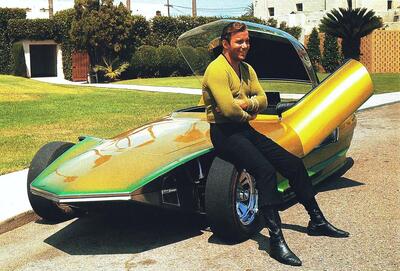
“Jade Idol” opened doors for Winfield, including a show-car project for an indoor car show promoter. After he fulfilled his touring obligations with “Reactor,” Winfield presented it to entertainment executives who used it in some of the era’s most significant TV productions. This outtake was from a photo session used to promote the “Bread and Circuses” episode in “Star Trek.” Photo courtesy: Gene Winfield.
In 1963, Promotions Inc., promoters of the famed Detroit Autorama among other events, commissioned Winfield to build a hand-formed asymmetrical body around a 427 Ford engine. “Strip Star” later appeared in Back to the Future II as a car from 2015.
Two years later, Hartford Autorama promoter Joe Kizis paid Winfield $20,000 to build a show rod based on a design by ArtCenter College of Design student Ben Delphia. The “Reactor” was an ambitious mid-engine, front-drive, aluminum-bodied sports car based on a Citroën DS suspension and powered by a turbocharged Corvair engine. The hydropneumatic suspension raised and lowered Reactor at driver’s will. “He always had an open mind,” Russ notes. “He wasn’t afraid to try anything.”
After completing the show circuit, Winfield promoted Reactor in entertainment circles. It appeared as the “Super Car” in “Bewitched,” as the “Jupiter 8” in the original “Star Trek,” “Catmobile” in “Batman,” and “The Freeze” in Mission: Impossible.
Reactor made Winfield a name among studio executives, who hired him to modify a Sunbeam Tiger for star Don Adams to drive in the “Get Smart” series. He gave Agent 86’s Tiger a cigarette lighter that doubles as a grenade and a car phone, an explosive throttle pedal, a poison-emitting radiator, a passenger-side ejector seat, a tailpipe that doubled as a machine gun and an oil slick dispenser, and a 50-caliber machine gun that emerged from a door in the hood.
In 1966, AMT hired Winfield to run its Speed & Custom Shop in Phoenix. Drawing upon his Hollywood credentials, AMT secured license to design and build the shuttlecraft for the first season of “Star Trek.” AMT also bought the rights to the Cycolac Research Vehicle (CRV), a concept car intended by Borg-Warner to explore the use of ABS plastic in automotive design. Winfield modified fullsize examples which AMT promoted as “Piranha” among car shows to sell scale-model variations. One Piranha appeared in “The MAN from U.N.C.L.E.” starting in 1967. Winfield oversaw numerous builds for commercial advertising projects, including splitting an Impala Super Sport down the middle for Chevrolet.
Recognizing the potential building for the entertainment industry, Winfield opened another California shop. Winfield’s Special Projects in North Hollywood built vehicles for Robocop, The Last Starfighter and—probably most notably—the 25 vehicles for Blade Runner and the flying DMC DeLorean for Back to the Future II.
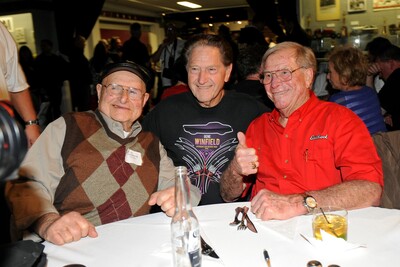
You know you’ve got some clout when SEMA founders Ed Iskenderian (left) and Vic Edelbrock Jr. (right) lean in and give thumbs-up when they have their photo taken with you. With his, well…genial personality, Winfield makes friends across industries. His willingness to invest in the people who work for or around him has a ripple effect across the automotive industry. Courtesy Gene Winfield.
Winfield relocated to Mojave, California after leaving the entertainment industry. But one could hardly call it a retirement; he began hosting classes to teaches enthusiasts tricks of the trade, including how to apply his trademark Winfield Fade. At 95, he still travels the globe showing students how to unlock the potential in automotive designs.


